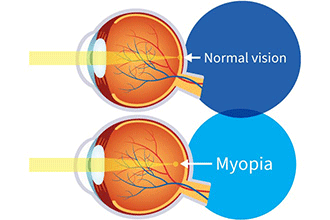Does Reading Books Cause Myopia
Reading books does not directly cause myopia. It can, however, exacerbate existing myopia or strain the eyes.
Myopia is primarily caused by genetic and environmental factors. Reading in low light or holding books too close may contribute to eye strain, but it is not a direct cause of myopia. It’s important to maintain proper lighting and distance when reading to minimize eye strain.
Additionally, taking regular breaks and practicing good eye care habits can help reduce the risk of eye problems. Overall, reading books in moderation and with good eye care practices is unlikely to cause myopia.

Credit: www.allaboutvision.com
The Myopia Epidemic
Myopia, commonly known as nearsightedness, has been on the rise in recent years, especially among children and young adults. Many researchers have linked this increase in myopia cases to the extensive use of digital devices and a significant decrease in outdoor activities. In this section, we’ll delve deeper into the factors contributing to myopia and explore the alarming rise in myopia cases.
The Rise In Myopia Cases
According to recent studies, the prevalence of myopia has reached epidemic proportions, particularly in developed regions. In some East Asian countries, it’s estimated that nearly 90% of the young adult population is affected by myopia. In the United States and Europe, the incidence of myopia has also doubled or tripled over the past few decades.
Factors Contributing To Myopia
Several factors play a role in the development of myopia, including genetic predisposition, prolonged near work, such as reading and screen time, and a lack of exposure to natural light. The excessive use of digital screens and electronic devices, coupled with a sedentary lifestyle, has further exacerbated the myopia epidemic.

Credit: comicphonics.com
Understanding Myopia
What Is Myopia?
Myopia, also known as nearsightedness, is a common vision condition where objects up close appear clear, but distant objects are blurred. It occurs when the eyeball is too long or the cornea has too much curvature, causing light to focus in front of the retina instead of on it. This leads to difficulty seeing objects at a distance.
How Does Myopia Develop?
Myopia often develops during childhood and tends to worsen as the eyes continue to grow. While genetics play a role, environmental factors such as prolonged near work, including reading, using electronic devices, and spending limited time outdoors, can also contribute to the development and progression of myopia.
The Role Of Reading
Reading is a fundamental activity that promotes knowledge, imagination, and cognitive development. However, there has been a long-standing concern about whether reading books, especially in low light settings or with incorrect posture, can contribute to the development of myopia, commonly known as nearsightedness. In this section, we will address both the myths and research surrounding the relationship between reading and myopia.
Myths About Reading And Myopia
- Reading in dim light or close proximity to screens causes myopia.
- Reading while laying down or in a reclined position leads to myopia.
- Reading books with small fonts increases the risk of myopia.
- Reading for extended periods without breaks is a major factor in myopia development.
Contrary to these common beliefs, scientific research has shed light on the true relationship between reading and myopia.
Research On Reading And Myopia
Extensive studies have been conducted to investigate the link between reading habits and myopia. While some initial research suggested a correlation, more recent studies have found weak or inconclusive evidence to support this claim. Here are a few key findings:
| Research Study | Key Findings |
|---|---|
| A study published in the British Journal of Ophthalmology (2016) | No significant association between reading habits and myopia development. |
| An analysis conducted by the National Eye Institute (2018) | Reading duration did not have a substantial impact on myopia progression. |
| A systematic review published in the journal Ophthalmology (2019) | No compelling evidence linking reading or near work to myopia development in children. |
These studies suggest that reading alone may not be a significant risk factor for myopia. While it is important to maintain a balanced approach to reading and engage in other activities, it is unlikely that reading itself directly causes myopia.
Other Factors To Consider
Reading books may not directly cause myopia, but there are other factors to consider. Spending excessive time reading without breaks, poor lighting, or sitting too close to the book can contribute to eye strain and potentially worsen nearsightedness.
While the link between reading books and myopia has been a subject of debate, there are other factors that should be taken into consideration as well. These factors include outdoor activities and myopia, as well as genetics and myopia. Let’s explore these factors in more detail.
Outdoor Activities And Myopia
Spending time outdoors has been found to have a protective effect against the development of myopia. Research suggests that children who spend more time outdoors have a lower risk of developing myopia compared to those who spend most of their time indoors. This could be due to various factors, such as exposure to natural light, distant objects, and reduced near-work activities.
Moreover, spending time outdoors can also help slow down the progression of myopia in children who are already nearsighted. This is why it’s important for parents to encourage their children to engage in outdoor activities regularly. Whether it’s playing sports, going for walks, or simply spending time in nature, every minute spent outdoors can make a difference.
Genetics And Myopia
Genetics also play a role in the development of myopia. If one or both parents have myopia, there’s a higher chance that their children will develop myopia as well. However, genetics alone do not solely determine whether a person will develop myopia or not. Environmental factors, such as reading habits and screen time, also contribute significantly to the development of myopia.
While we can’t change our genetic predispositions, we can still take steps to reduce the risk of myopia and its progression. Encouraging a healthy lifestyle that includes regular outdoor activities, balanced screen time, and good reading habits can help mitigate the impact of genetic factors.
Conclusion
While reading books alone may not directly cause myopia, it’s important to consider the various factors that can contribute to the development and progression of this visual condition. By understanding these factors and making proactive lifestyle choices, we can help protect our eyes and maintain good eye health.
Preventing And Managing Myopia
To prevent and manage myopia, it’s important to consider factors like reading habits. While excessive reading may not directly cause myopia, prolonged near work can contribute to its progression. To minimize the risk, it’s advisable to take breaks, maintain proper lighting, and practice good posture while reading.
Myopia, commonly known as nearsightedness, is a growing concern among children and adults alike. With the increasing use of digital devices and limited outdoor activities, the prevalence of myopia has soared in recent years. But the good news is, there are steps you can take to prevent and manage myopia effectively. In this section, we will discuss some practical tips to reduce myopia progression and stress the importance of regular eye exams.
Tips For Reducing Myopia Progression
If you or your child have been diagnosed with myopia, don’t worry. There are several strategies you can implement to slow down the progression of myopia. Here are some useful tips:
- Limit screen time: Excessive screen time can strain the eyes and worsen myopia. Encourage breaks from screens every 20 minutes and try to limit overall usage.
- Encourage outdoor activities: Spending time outdoors has been linked to a reduced risk of myopia. Encourage your child to engage in outdoor activities and sports regularly.
- Create a reading-friendly environment: Ensure proper lighting and maintain an appropriate reading distance to reduce eye strain while reading.
- Follow the 20-20-20 rule: Remind yourself and your child to take a break every 20 minutes and look at something 20 feet away for 20 seconds to relax the eyes.
- Consider orthokeratology: Orthokeratology, or ortho-k, involves wearing specially designed contact lenses that reshape the cornea overnight. This temporary vision correction method can slow the progression of myopia.
- Encourage healthy eye habits: Avoid rubbing the eyes, as it can worsen myopia. Ensure proper posture while studying or using digital devices to minimize eye strain.
The Importance Of Regular Eye Exams
Regular eye exams play a crucial role in preventing and managing myopia. They help identify myopia progression at an early stage, allowing for timely intervention. Here are some reasons why regular eye exams are essential:
- Early detection: Regular eye exams enable early detection of myopia or any changes in vision. This helps prevent further complications and allows for prompt management.
- Prescription updates: Myopia can worsen over time, requiring prescription adjustments. Regular eye exams ensure that your glasses or contact lenses accurately correct your vision.
- Monitoring eye health: Eye exams assess the overall health of your eyes, checking for any underlying conditions or abnormalities that may contribute to myopia or other visual problems.
- Professional guidance: Optometrists can provide personalized advice on managing myopia, including lifestyle modifications and treatment options.
By following these tips and scheduling regular eye exams, you can effectively prevent and manage myopia. Remember, early intervention is key to maintaining good eye health and preserving clear vision.

Credit: www.optometrists.org
Frequently Asked Questions For Does Reading Books Cause Myopia
Does Reading Books Cause Myopia?
No, reading books itself does not cause myopia. However, excessive reading without breaks can strain your eyes.
Can Reading In Low Light Cause Myopia?
Reading in low light does not directly cause myopia, but it can strain your eyes and affect your vision temporarily.
How Can I Prevent Myopia From Reading?
To prevent myopia while reading, take frequent breaks, maintain proper lighting, and ensure your reading material is at a comfortable distance.
Conclusion
There is no concrete evidence to suggest that reading books directly causes myopia. However, it is important to maintain a healthy balance between reading and other activities, especially those involving outdoor exposure. Engaging in regular eye exercises and practicing good reading habits, such as proper lighting and taking breaks, can also help alleviate any potential strain on the eyes.
Ultimately, moderation and maintaining overall eye health are key factors in mitigating the risk of myopia.




